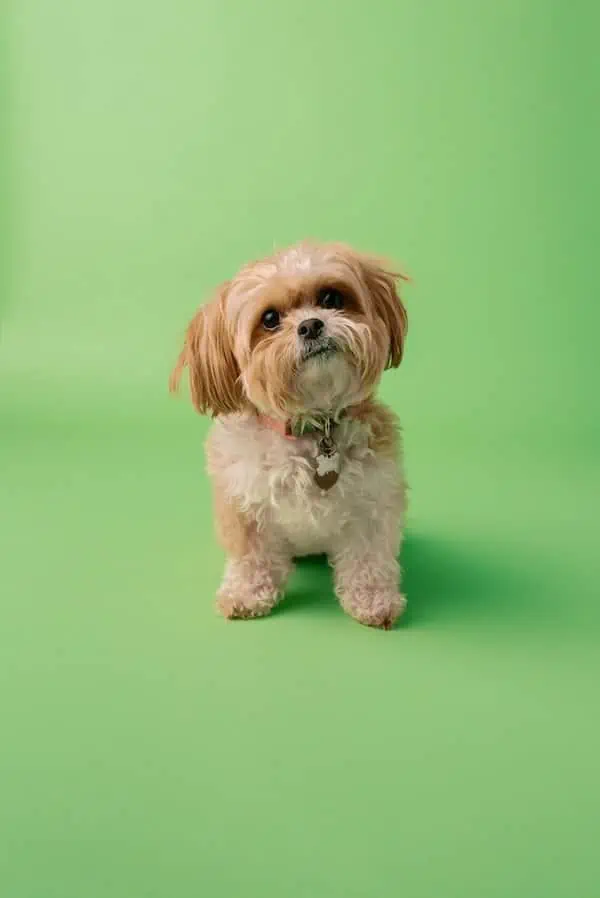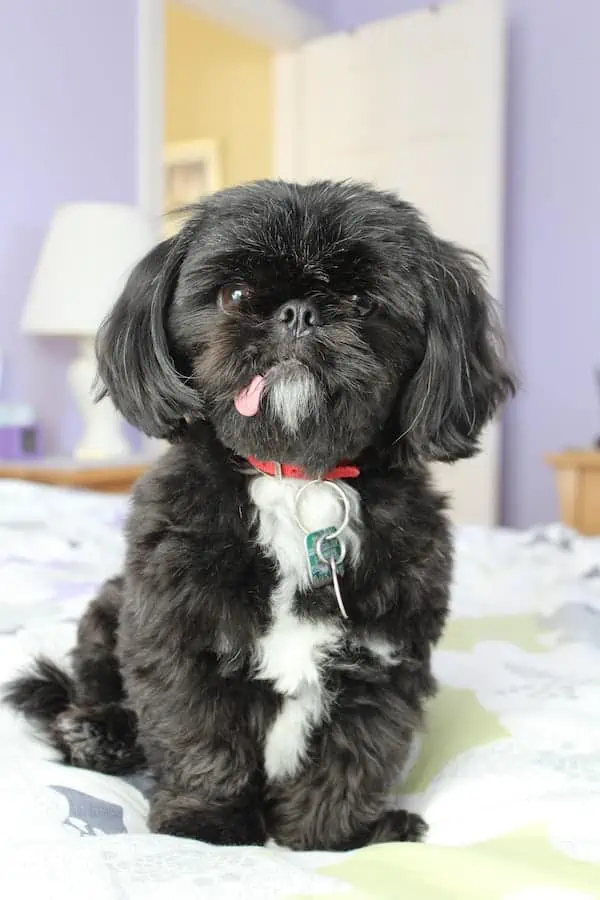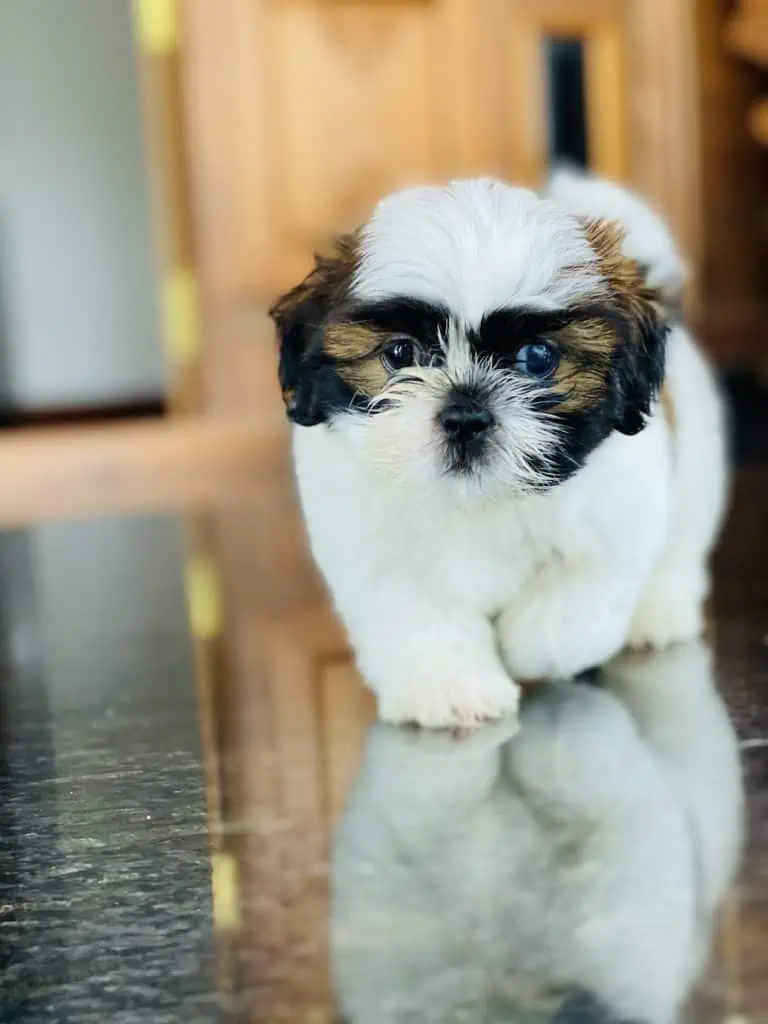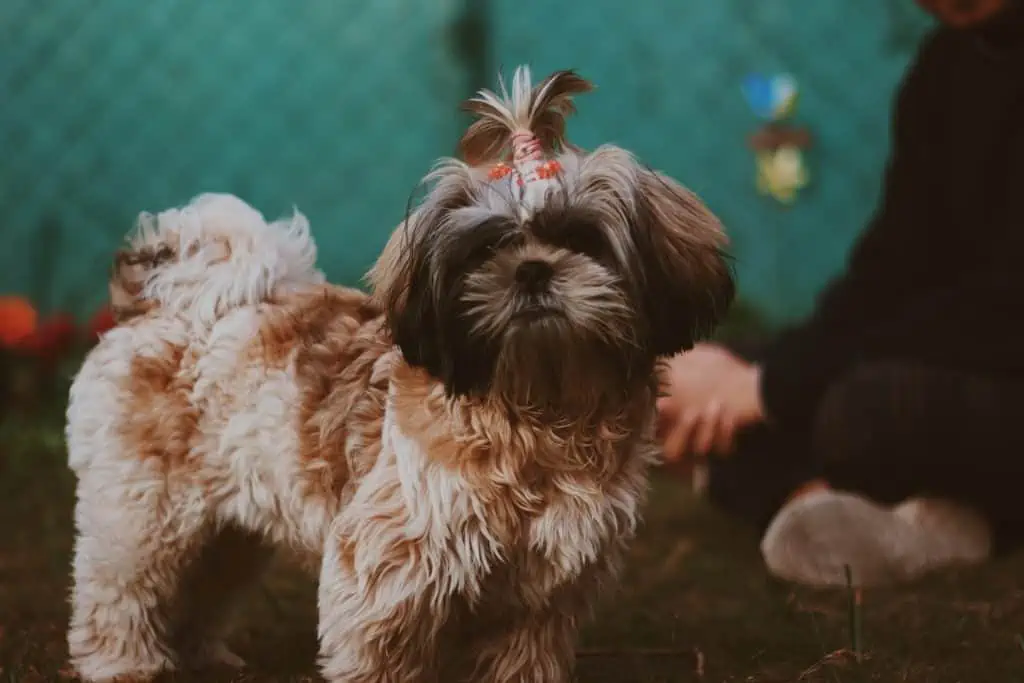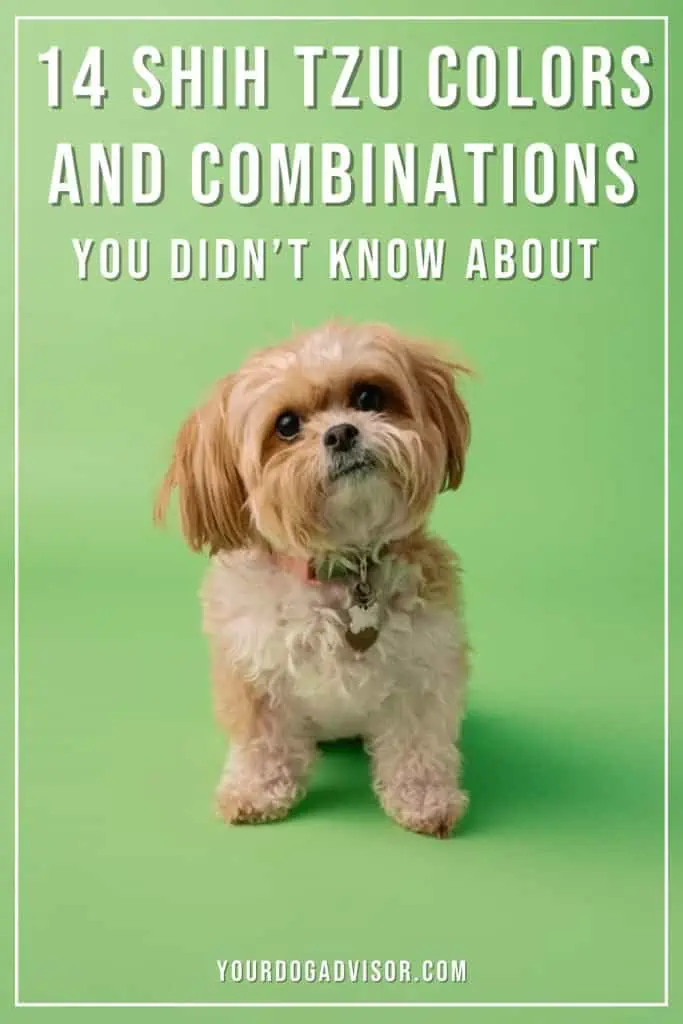Shih Tzus are a popular and beautiful breed famous for their adoring temperaments and companionable traits. They make excellent dogs for first-time dog owners, families with older children, singles, seniors, retirees, and couples.
These tiny pups are also popular show dogs, with their coats often winning them top prizes in the ring. This is because Shih Tzu coats are a thing of beauty, especially when they are allowed to grow out long and silky.
Not only are Shih Tzu coats coveted, but Shih Tzu colors and combinations are also a sight to behold. If you’re a Shih Tzu lover excited to learn more about the different types of coat colors and combinations you can find in a Shih Tzu, you’ve come to the right place.
Contents
The Shih Tzu Coat – What To Expect When It Comes To Shih Tzu Coat Colors, Patterns, and Textures
Shih Tzu coat colors can come in many varieties, but they are primarily recognized in 14 colors and combinations.
Shih Tzu dogs are popular for a number of reasons, as we mentioned, but one of the many reasons is their soft, hair-like fur.
These dogs are hypoallergenic, which means they produce less allergy-inducing dander than other breeds, thus making them ideal for owners who struggle with allergies. This wonderful trait also leads to a coat that can grow out long, looking more like human hair than canine fur.
Shih Tzu coats are also somewhat wavy, depending on their length, and they come in a variety of Shih Tzu colors, combinations, and patterns.
Like many dogs, Shih Tzu colors can vary and extend far beyond the most common coat colors you might expect to see in the breed. But there are 14 Shih Tzu colors and combinations most favorable when it comes to Shih Tzus.
These 14 Shih Tzu Colors And Combinations Include
- Black
- Black and White
- Blue
- Blue and White
- Brindle
- Brindle and White
- Red
- Red and White
- Liver
- Liver and White
- Silver
- Silver and White
- Gold
- Gold and White
All of these above Shih Tzu colors and combinations are not only beautiful, but they are also the only colors and combinations recognized by most major breed clubs for show.
Let’s learn more.
The 7 Official Shih Tzu Colors Recognized By The American Kennel Club
Black Shih Tzus are some of the some of the rarest Shih Tzu colors.
When it comes to major breed clubs like the American Kennel Club (AKC), there are strict rules and guidelines that qualify certain breeds to register, be recognized by the AKC, or be eligible for show. Only purebred dogs can be registered or recognized by the American Kennel Club, and only dogs with the purest of bloodlines.
This means that dogs with coat colors outside of recognized Shih Tzu colors will not be eligible for show.
The Shih Tzu colors recognized by the American Kennel Club are listed below:
Blue
Blue Shih Tzus are a rarity when it comes to Shih Tzu colors, though it is not actually blue and instead a term used to describe a grayish blue color in the Shih Tzu dog’s coat. This lovely blue shade is so rare because it comes from a diluted gene known as the D Locus/Blue gene.
The gene dilutes pigment in coat colors, leading to this shade. It is also a recessive gene, meaning it can be difficult for breeders to properly predict the parent breeds that carry it. Furthermore, even if you were to breed two blue Shih Tzu dogs, there is no sure chance that their offspring will be blue as well.
Black
Black Shih Tzu dogs are lovely, but you’ll probably have to think long and hard about if you’ve ever actually seen a black Shih Tzu before. This is because black Shih Tzu colors are the rarest Shih Tzu colors, and most of the time these black dogs will include patterns of white on their fur.
This white is often on their chest, underbelly, and paws. Sometimes, though, in very rare instances, you might come across an all-black Shih Tzu.
Brindle
Chances are you’ve seen a brindle Shih Tzu in the past. This is a very popular coat color when it comes to Shih Tzu colors. On short-haired dog breeds, the brindle color can look like exotic stripes or patterns, but on Shih Tzus, who have longer, more wavy hair, the color comes as a sort of tan, brown, and black speckled pattern.
You may notice different shades in the fur as if the dog has had their hair highlighted professionally, as well as markings on the ears, muzzle, and paws.
Liver
Also known as brown or chocolate-colored Shih Tzus, liver is a common Shih Tzu color that describes not only the fur color of the Shih Tzu but also the skin color.
Most Shih Tzus are a combination of liver and white, with darker brown fur on top and white markings on their chest, belly, and paws. Though more common than black and blue, liver is considered one of our rarer Shih Tzu colors.
Silver
Many silver Shih Tzu dogs are described as simply white Shih Tzus, but in reality, white Shih Tzus are not actually recognized by the American Kennel Club or many other major breed clubs or registrations.
The silver Shih Tzu is not always all silver either. In fact, like most of our Shih Tzu colors on this list, silver Shih Tzu dogs have combinations of white or sometimes black in their fur, especially around their muzzle and ears.
Red
Many Shih Tzu puppies are born with a red or orangish-looking coat, and while red is a common Shih Tzu color in young dogs, it can fade over time and become brindle or gold.
However, some adult Shih Tzu dogs will maintain their red coat, with many also having combinations of black on their muzzle, ears, and paws. If not black, then red-colored Shih Tzus might have white markings or patterns instead.
Gold
Another color that belongs in our rare Shih Tzu colors list is the gold-colored Shih Tzu. Sometimes mistaken for brindle, gold-colored Shih Tzus are almost fully covered in a lush gold coat, similar in color to that of a Golden Retriever.
However, these dogs also often have darker or lighter markings on their muzzles, ears, and paws. Most commonly, gold Shih Tzu colors are accompanied by white on the belly and chest.
Shih Tzu Markings And Patterns
Along with all these Shih Tzu colors above, you are likely to have any color combination or marking, including black markings, tan markings, or black masks.
So, now that we’ve covered all the recognized Shih Tzu colors, what other Shih Tzu colors and coat patterns might you see in a Shih Tzu that the American Kennel Club does not recognize?
Keep reading to find out!
Different Coat Colors And Patterns You Might See In A Shih Tzu
Masking is a common pattern you might see in Shih Tzus.
For people invested in competing with their canines, investing in a Shih Tzu with an accepted coat color is a necessity.
However, many Shih Tzu lovers simply want to invest in a Shih Tzu for companionship, and if that’s the case you may not be as concerned about Shih Tzu colors and which colors are officially recognized by the American Kennel Club.
If that’s the case, then you should consider the below Shih Tzu colors. While these colors will deem your dog disqualified for show, they are still lovely and won’t have any impact on your Shih Tzu dog’s personality or health.
Saddle
The saddle-colored Shih Tzu has a saddle-like color pattern on its back, going from the shoulders to the rump. The pattern is called “saddle” because it often resembles a horse saddle, and is typically a different color from the rest of your dog’s dominant color.
White
As we mentioned above, there is no such thing as a true white Shih Tzu, according to the American Kennel Club. However, there are white Shih Tzu dogs available that may not be 100% pure Shih Tzus.
Even with white Shih Tzu dogs, chances are you will have some sort of color combination included, whether you have black or brown markings, even if they are small.
Blaze
A blaze-colored Shih Tzu may sound like something out of an action movie, but this color is actually more of a pattern. In fact, it details a stripe of color that falls down the forehead of the Shih Tzu and between his eyes.
This color can vary depending on your Shih Tzu, but it is almost always going to be a different color from your dog’s all-over color. For example, if your Shih Tzu is silver, he may have a blaze coat pattern if he has a black streak running from his back or neck to between his eyes.
Collar Or Shawl
Shawl colored Shih Tzus, also known as collar-colored Shih Tzus, are another color combination and pattern not recognized by the American Kennel Club. This pattern describes when the Shih Tzu dog’s dominant coat color is only different around the neck, hence the terms “shawl” or “collar” used to describe it.
Tuxedo
This dapper-sounding pattern looks just as you would imagine on a Shih Tzu – it makes them appear as if they are dressed to impress! Tuxedo Shih Tzu dogs are often black with a small bit of white on the chest, but they can also be other colors as well like liver, silver, or red.
Flare
If you think the term “flare” sounds like it should coincide with the term “blaze”, you’re not wrong. In fact, the two are almost similar enough to be confused for one another, although this color pattern starts out thin at the forehead and streaks down, getting wider at the shoulder blades.
Shih Tzu Colors That Are Linked To Health Problems In These Dogs
All white Shih Tzu dogs may be more prone to hereditary deafness.
Shih Tzu dogs are relatively healthy, and coat color generally does not play a part in their overall health and vitality.
There is one exception to that rule, though it’s so rare you’ll be hard-pressed to find much information on it in regards to the Shih Tzu, especially considering this coat color isn’t a formally recognized coat color in the breed.
We are, of course, talking about white Shih Tzu dogs, who may be more prone to suffering from hereditary deafness than their other colored Shih Tzu counterparts.
White Shih Tzus may contain a genetic trait that reduces the pigmentation in their fur, and this gene also impacts the nerves in the ear canal. This can lead to all white Shih Tzu dogs being born deaf or even partially deaf.
With that said, this is rare.
Otherwise, all Shih Tzu colors can be prone to the same number of health issues, especially as they age.
These health issues include but may not be limited to Brachycephalic Airway Syndrome, allergies, skin conditions, ear infections, tracheal collapse, cataracts, proptosis, progressive retinal atrophy, eye injuries, hip dysplasia, hypothyroidism, luxating patella, portosystemic shunt, and Cu tzung’s disease.
Proper exercise, diet, routine veterinarian visits, and ensuring you get your Shih Tzu puppy or rescue dog from a reputable source can all help combat significant health issues for you and your pup.
Best Tips For Grooming Your Shih Tzu And Keeping That Coat Healthy
Grooming, diet, and routine vet visits can help keep your Shih Tzu’s coat looking its best.
If you’re planning on investing in a Shih Tzu, you should plan for a good amount of grooming. This is true whether you are investing in a show-quality Shih Tzu or simply a Shih Tzu dog for companionship.
Remember, Shih Tzu dogs tend to have more human-like hair than they do fur, and this unique coat texture can grow out quite long. If you wish to keep your Shih Tzu coat short, you do have the option of keeping it in a puppy cut.
This cut is much easier to maintain, and will also ensure your Shih Tzu stays free of mats and tangles during day-to-day activities.
However, if you plan on showing your Shih Tzu competitively, you may end up growing his fur out to floor length. If this happens, you’ll want to take care to brush and groom your Shih Tzu daily. You should also be careful to keep your dog’s fur out of his eyes, as this can lead to eye irritation as well as increased tear production.
Tear stains can be a problem for Shih Tzu colors that are lighter, like silver and brindle Shih Tzus. Luckily, there are plenty of products you can invest in to help reduce Shih Tzu tear stains and keep that coat looking lovely.
Diet will also play a role in the overall health and shine of your Shih Tzu’s coat and even the brightness of those Shih Tzu colors.
The best dog food for a Shih Tzu is going to be a high-quality dog food specified for your Shih Tzu’s age, weight, and activity level.
Choose dog foods that contain real animal protein and have a good amount of carbs, fatty acids, vitamins, nutrients, minerals, and water to ensure your Shih Tzu is getting all the nutrition he needs in order to thrive.
Remember, while not all Shih Tzu colors are recognized by the American Kennel Club, that doesn’t mean you can’t enjoy your unofficial Shih Tzu colors and combinations just as much.
So, which of the above Shih Tzu colors caught your attention the most? Tell us below!
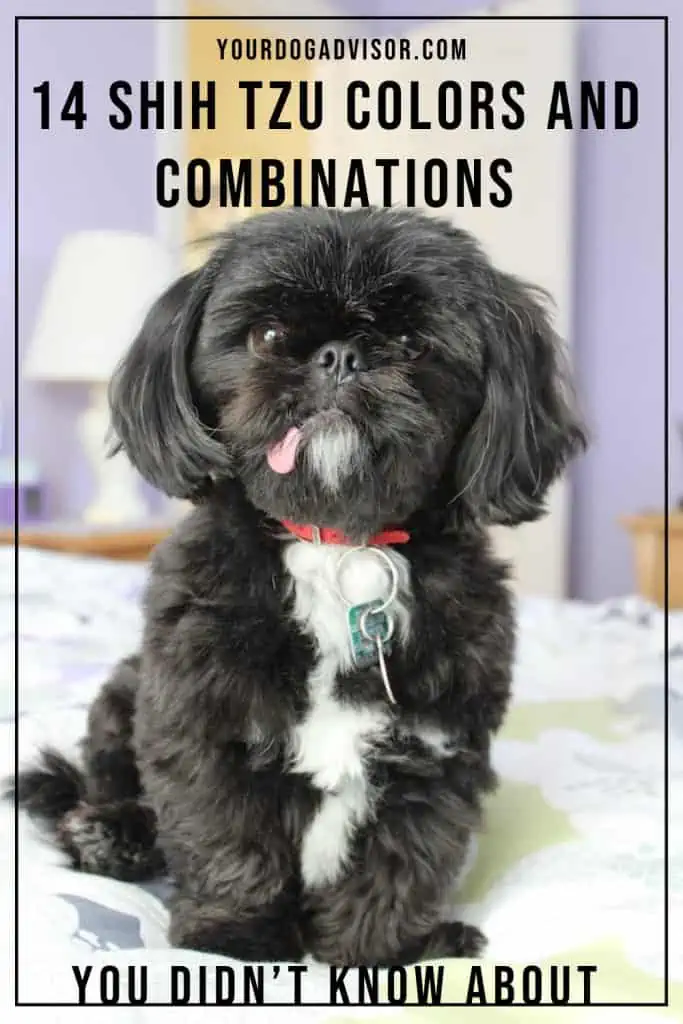

Jen Jones is a professional dog trainer and behavior specialist with more than 25 years of experience. As the founder of ‘Your Dog Advisor’ and the ‘Canine Connection’ rehabilitation center, she applies a holistic, empathetic approach, aiming to address root causes rather than merely treating symptoms.
Well known for her intuitive and compassionate approach, Jen adopts scientifically-proven, reward-based methods, encouraging positive reinforcement over punishment. Jen specializes in obedience training, behavior modification, and puppy socialization. Her innovative methods, particularly in addressing anxiety and aggression issues, have been widely recognized. Jen has worked with many of the world’s leading dog behaviorists and in her free time volunteers with local animal shelters and rescue groups.
